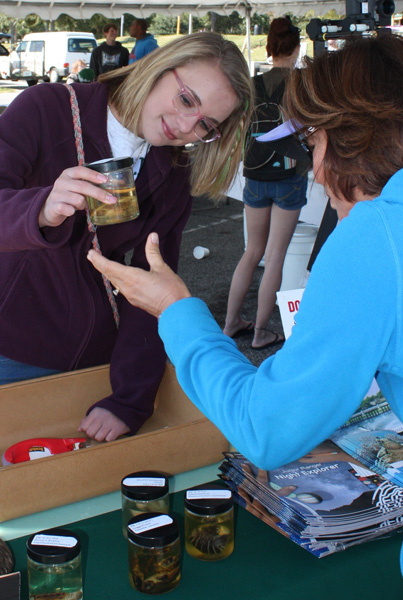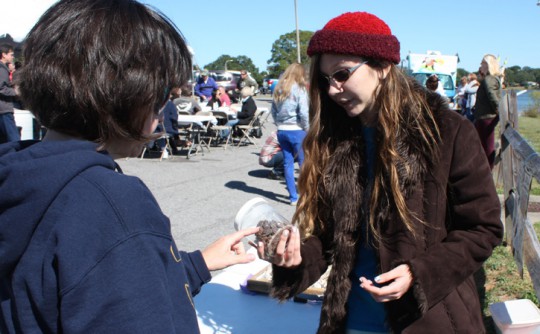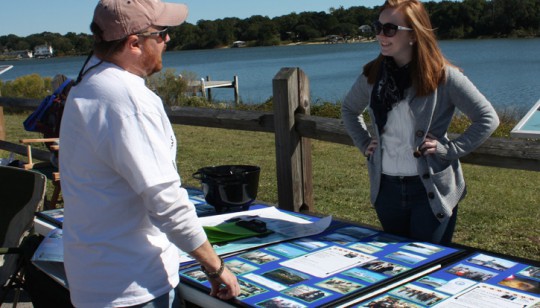High School Marine Programs Working To Protect Local Environment
November 5, 2014
Instructors and students from four Escambia Marine Science Education programs teamed up recently to fry hundreds of pounds of mullet and to educate the community about the four high school programs and their ongoing research projects.
One of the projects, Bringing Back the Bayous, involves students from Washington, West Florida, Escambia and Pensacola high schools collecting water samples. The samples are taken from Bayou Texar, Bayou Chico, Bayou Grande and Perdido Bay. The samples are transported to Washington High where biology and chemistry students measure the levels of chlorophyll and other nutrients such as phosphates and nitrogen in the local water.
 “When these levels get too high, the water ways experience algal blooms that kill fish and damage local ecosystems,” explained Allie Fuller, Washington High senior and president of Washington’s Marine Science Academy. As a senior, she has had a variety of research opportunities in her four years in the program. She and classmates have collected water samples, planted sea grass, replenished the shorelines, and collected sea life in seine nets. They have learned how to properly test the water’s quality and how to report numbers of local species in diversity studies.
“When these levels get too high, the water ways experience algal blooms that kill fish and damage local ecosystems,” explained Allie Fuller, Washington High senior and president of Washington’s Marine Science Academy. As a senior, she has had a variety of research opportunities in her four years in the program. She and classmates have collected water samples, planted sea grass, replenished the shorelines, and collected sea life in seine nets. They have learned how to properly test the water’s quality and how to report numbers of local species in diversity studies.
Fuller was a pioneer in Washington High’s program and she believes Pensacola needs more scientists so they can educate the public about the causes of local water pollution and how to avoid making things worse. “We have learned how to help by cleaning out the baffle boxes to keep big trash from washing into the bay. We also have added oyster shells and plant life to help reduce run-off and prevent erosion.”
Kevin Turner, a marine science instructor at Washington High School, says his wish is to teach his students how they can help clean up our local waterways. “We work with three other schools so water samples can be collected at more locations. All of the schools send their samples to us for testing. The reagents we need for the testing process are expensive. That’s why we decided to hold this fish fry, to raise money.”
Around $4000 was raised to help the Bayou project.
For Madison Meyer, a junior from Escambia High School, the recent event was a chance to tell more people about the Turtle T.H.I.S. (Teens Helping In the Seashore) project and to ask everyone to remember the negative effect bright lights can have along the coast for sea turtles. “People who live by the water need to shade their lights so the light can go where they need it, but not go where it’s not needed, because it affects turtles. If you need to use a flashlight, you should always use a red light.”
Meyer’s involvement in this project has also introduced her to a possible future employer, the National Parks. “I want to go into marine biology, and I plan to work for the park service, because you can go anywhere.”
“The people of Pensacola have become complacent,” said Jennifer Sublett, a junior at West Florida High School, when she was asked why it was important for her to be there talking to the public. Last spring, WFHS students collected tar patties from local beaches as part of Project G.O.O. (Gulf Oil Observers). The students learned the proper protocol for collecting the tar samples and then sent 40 patties to the Woods Hole Oceanographic Institute to have them analyzed.
“Twenty six of our samples had the same composition as the tar from the BP Deep Water Horizon oil spill. This is important to know, because it tells us we still have a lot of oil out there from the spill,” Sublett said. This year, WFHS students will continue this work as part of Project G.O.O. II.
While Meyer and Fuller now know this experience is just a beginning in their interest in working in a scientific field (Meyer in the park system and Fuller in the nature cinemagraphic field), Sublett isn’t so sure just yet. But, she said that isn’t important, because she has already learned from her WFHS instructor, Shawn Walker, that anyone can be a citizen scientist.
“If you learn the right way to help, you can collect samples and help someone (a scientist) with their research,” explained Sublett.
Pictured top: Pictured inset: Jennifer Sublett, a junior marine science student at West Florida High School, explains the process and protocols used to collect sample tar balls from local beaches by students working with Project GOO (Gulf Oil Observers). Madison Meyer, Escambia High junior, explains what she has learned about turtles to Rayeko McCartan. Pictured below: Allie Fuller, Washington’s Marine Science Academy president and senior, and Kevin Turner, a Marine Science instructor at Washington High, presented information about the marine science program. Photos for NorthEscambia.com, click to enlarge.





Comments